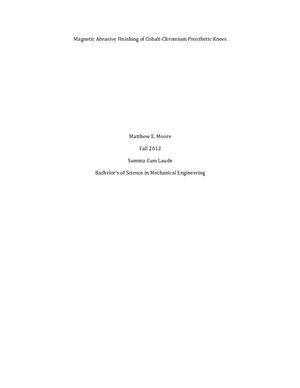Флоридский университет (University of Florida), 2012. – 40 с. (на
англ. яз.)
Специальность: Машиностроение (Mechanical Engineering). Автор: М. Мур (Moore M.E. ). Руководитель: Х. Ямагучи (Hitomi Yamaguchi Greenslet). Название на русском языке: Магнитно-абразивная обработка коленных протезов из кобальт-хрома. Аннотация на англ. языке:
The freeform surface of a prosthetic knee presents difficulties in manufacturing, particularly with polishing. A finishing process is required to reduce the surface roughness to less than 5 nm Sa without disturbing the form accuracy. It is difficult for automated processes to realize such fine control of material removal. The finishing process is, therefore, often performed manually, leading to an increase in quality variation and production cost. This study proposes using Magnetic Abrasive Finishing to finish cobalt-chromium (Co-Cr) prosthetic knees. The objectives were to develop a method to improve the surface roughness, reduce the quality variation, and improve tribological properties to extend the lifespan of a prosthetic. For this study, a prosthetic knee is mounted on a six-axis robot, and the motion required to achieve freeform surface finishing is controlled by the robot program. This study focuses on finishing parameters such as the magnetic field characteristics and workpiece feed rate, and their effects on finishing characteristics.
Специальность: Машиностроение (Mechanical Engineering). Автор: М. Мур (Moore M.E. ). Руководитель: Х. Ямагучи (Hitomi Yamaguchi Greenslet). Название на русском языке: Магнитно-абразивная обработка коленных протезов из кобальт-хрома. Аннотация на англ. языке:
The freeform surface of a prosthetic knee presents difficulties in manufacturing, particularly with polishing. A finishing process is required to reduce the surface roughness to less than 5 nm Sa without disturbing the form accuracy. It is difficult for automated processes to realize such fine control of material removal. The finishing process is, therefore, often performed manually, leading to an increase in quality variation and production cost. This study proposes using Magnetic Abrasive Finishing to finish cobalt-chromium (Co-Cr) prosthetic knees. The objectives were to develop a method to improve the surface roughness, reduce the quality variation, and improve tribological properties to extend the lifespan of a prosthetic. For this study, a prosthetic knee is mounted on a six-axis robot, and the motion required to achieve freeform surface finishing is controlled by the robot program. This study focuses on finishing parameters such as the magnetic field characteristics and workpiece feed rate, and their effects on finishing characteristics.

